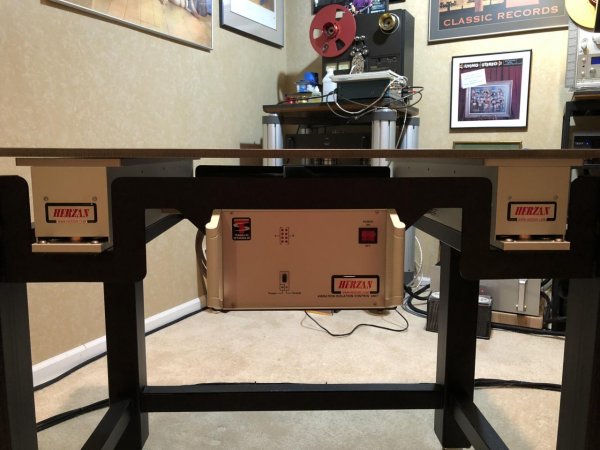Hi David,
I would associate "dead" with a lack of dynamics and liveliness, which is the opposite of what it brings to the "table". The reason we recommend buy before you try is that panzerholz "extends" the vibration reduction bandwidth of the tablestable. A big difference with most passive platforms is the tablestable actually acts and compensates vibrations of the component sitting on top. Some turntables use material resonances to "flavour" the sound. If you counteract on or damp these resonances you remove that "flavour".
For example, adding resonances in the 125-500Hz range can add fullness or warmth to the sound. Adding resonances in the 500Hz to 2K range can increase apparent definition and bite. Above 2K you can add resonances to increase apparent presence, clarity, sparkle etc. but we're now into entering into the range where there's not enough physical airborne energy which can couple to the structural section of the turntable to significantly excite resonant nodes. You need a certain amount of energy to be able to move mass, the lower the frequency at an energy level the more mass it is able to "move". For a passive platform increasing mass is a good way to increase isolation bandwidth down in frequency range.
Isolation is of course not equivalent to damping. You would call the tablestable and isolating device, but it isn't, it is dissipating vibrational energy by producing a counter force. By adding the panzerholz topplate we did not increase the isolation bandwidth but added damping to extend the isolation of the tablestable.
The active correction is very effective up till around ~40Hz where it can attenuate vibrations up to ~50dB, performance then rolls off to around ~-6dB from around 150-200Hz at which point it's acting as a strictly passive isolating/damping device up till around 1KHz.
The panzerholz is roughly doubling the total tablestable damping performance from ~150-1000Hz and extends the damping range to well over 2K.
At this point it may be useful to explain why we're going through the trouble of using panzerholz. It's not being used much, I suspect, because it's a nightmare for machining tools, it eats CNC tools for breakfast and likes to have a few more before lunch too, literally! It's also very expensive and is usually build to order, the combination of which leads to low default stocks.
The numbers of interest here are damping factor (actual damping), transmissibility (how well sound is transported through the material) and frequency (properties vary by frequency magnitude).
For Panzerholz, the damping factor at 200Hz is ~0.7, the transmissibility is ~1.5, at 1000Hz the damping factor is ~0.9, transmissibility is ~1.
Now lets compare this to some other materials, lower damping factor is lower damping, higher transmissibility is better transmissibility, listing 200Hz only:
Wood:
Walnut: DF 0.01, T 50
Oak: DF 0.01, T 27
Pine: DF 0.06, T 11
MDF: DF 0.02, T 42
Plyboard: DF 0.04, T 18
Cork: DF 0.1, T 6
Metal:
Aluminium: DF 0.004, T 177
Copper: DF 0.01, T 71
Steel: DF 0.08, T 88
Lead: DF 0.03, T 22
Various commonly used material:
Carbon Fibre: DF 0.06, T 12
Marble: DF 0.01, T 80
Slate: DF 0.02, T 42
Rubber: DF 0.3, T 2.5
Sorbothane: DF 0.2, T 4
Just for fun:
Vinyl record: DF 0.02, T 35
Vinyl record on bare metal platform: DF 0.05, T 13
Vinyl record on bare metal platform with platter mat: DF 0.12, T 6
Vinyl record as above with record clamp: DF 0.1, T 7
As you can see Panzerholz has some unique properties which make it very interesting for hifi applications. Unfortunately its not used much, the few companies I am aware of are Kaiser Acoustics, Lessloss, Clearaudio and us ofcourse!
Disclaimer: I am not a native English speaker so I had to translate some technical Dutch terms into English, hopefully I got everything right.



